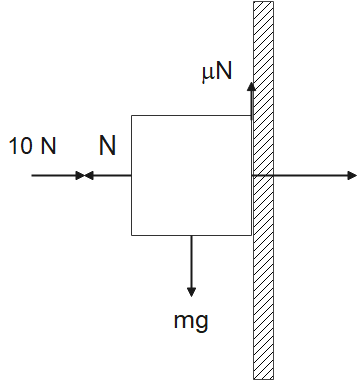
A horizontal force of 10 N is necessary to just hold a block stationary against a wall. The coefficient of friction between the block and the wall is 0.2. Find out the weight of the block.

a.) 50 N
b.) 100 N
c.) 2 N
d.) 20 N

Answer
524.4k+ views
Hint: In this question, we have been asked to find out the weight of the block and we have been given the condition that we need to apply a force of 10 Newton to just make sure that the block does not slip off the wall. We have been given the normal reaction and the force applied to the block and also a diagram of the condition
Complete answer:
In this question, we have been given few quantities such as
Force applied (F) = 10 N
Normal Reaction (R) = 10 N
Frictional Force $f=\mu N$
Where, $\mu $ is the coefficient of friction and “N” is the normal reaction which in this question is shown as “R”
$\mu $ = 0.2
Now, we know that the force applied is balanced by the normal reaction
Therefore, we can say,
F = R
Or, 10N = R (because Force applied (F) = 10 N )
Therefore, Normal Reaction (R) =10 N
Now, the frictional force $f=\mu N$ is balanced by the weight “mg”
$\mu N=mg$
Putting the values, of $\mu $ , N
We get,
$(0.2)(10)=mg$
mg = 2 N
Therefore, Weight of the block is 2 Newton
Hence, we can conclude that option (c) is the correct answer.
Note:
Frictional force always acts opposite to the direction of motion, hence in this figure the frictional force totally balances the weight of the body which makes it totally stable and it does not slip off the downside. If the force of gravity or weight is stronger than the block will move in the downward direction because the forces will not be balanced.
Complete answer:
In this question, we have been given few quantities such as
Force applied (F) = 10 N
Normal Reaction (R) = 10 N
Frictional Force $f=\mu N$
Where, $\mu $ is the coefficient of friction and “N” is the normal reaction which in this question is shown as “R”
$\mu $ = 0.2
Now, we know that the force applied is balanced by the normal reaction
Therefore, we can say,
F = R
Or, 10N = R (because Force applied (F) = 10 N )
Therefore, Normal Reaction (R) =10 N
Now, the frictional force $f=\mu N$ is balanced by the weight “mg”
$\mu N=mg$
Putting the values, of $\mu $ , N
We get,
$(0.2)(10)=mg$
mg = 2 N
Therefore, Weight of the block is 2 Newton
Hence, we can conclude that option (c) is the correct answer.
Note:
Frictional force always acts opposite to the direction of motion, hence in this figure the frictional force totally balances the weight of the body which makes it totally stable and it does not slip off the downside. If the force of gravity or weight is stronger than the block will move in the downward direction because the forces will not be balanced.
Recently Updated Pages
Why are manures considered better than fertilizers class 11 biology CBSE

Find the coordinates of the midpoint of the line segment class 11 maths CBSE

Distinguish between static friction limiting friction class 11 physics CBSE

The Chairman of the constituent Assembly was A Jawaharlal class 11 social science CBSE

The first National Commission on Labour NCL submitted class 11 social science CBSE

Number of all subshell of n + l 7 is A 4 B 5 C 6 D class 11 chemistry CBSE

Trending doubts
What is meant by exothermic and endothermic reactions class 11 chemistry CBSE

10 examples of friction in our daily life

One Metric ton is equal to kg A 10000 B 1000 C 100 class 11 physics CBSE

1 Quintal is equal to a 110 kg b 10 kg c 100kg d 1000 class 11 physics CBSE

Difference Between Prokaryotic Cells and Eukaryotic Cells

What are Quantum numbers Explain the quantum number class 11 chemistry CBSE




